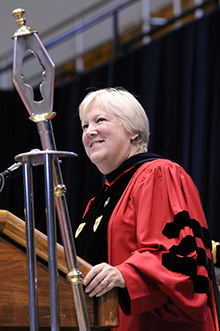After 22 years, more than 700 university events and more handshakes, smiles and encouraging words than she could ever tally up, GW’s university marshal, Jill Kasle, is hanging up her academic robes and putting away her mace.
Ms. Kasle, an associate professor of public policy and public administration, has served as the university’s chief ceremonial officer since 1989. She will participate in one more major university event—the freshman convocation ceremony on Aug. 28. After that, the Office of the Provost will adopt a new format for ceremonial occasions that will allow various university faculty members and administrators to serve in the marshal role.
The role of university marshal originated at the University of Oxford in England more than 500 years ago. Back when the university and the town of Oxford were one and the same, the marshal would walk through town ahead of the university rector (president) waving the mace—which was a weapon: a heavy staff sometimes topped by a spiked metal ball on a chain. The idea, Ms. Kasle said, was to protect the university leader.
In modern times, the marshal role has evolved to be the master of ceremonies at formal university occasions, and the mace is no longer quite as intimidating. GW’s mace is a staff topped with four flanges displaying profiles of George Washington. It was designed by Harry Irving Gates, a professor emeritus of sculpture.
In addition to presiding over commencements and convocations, the marshal has been responsible for welcoming heads of state and other dignitaries to campus.
Ms. Kasle said meeting First Lady Michelle Obama during the 2010 commencement ceremony and placing her honorary doctoral hood was “absolutely spectacular.” Another highlight was holding hands with jazz legend Ella Fitzgerald, when GW awarded her an honorary degree at Wolf Trap National Park for the Performing Arts in 1991. “She was old and somewhat frail. We came out of the wings, she took my hand, and we walked out together,” Ms. Kasle said.
At only one event can Ms. Kasle recall being nervous. That was in 1991, when the university honored President Ronald Reagan with an honorary degree and dedicated the Ronald Reagan Institute of Emergency Medicine. President Reagan had been treated at the GW Hospital in 1981, after a would-be assassin shot him.
Without the responsibility of being the university’s sole ceremonial leader, Ms. Kasle expects she’ll have a lot more free time, especially during the spring semester. She will still be a full-time faculty member with classes to teach and students to advise, but she’s also looking forward to enjoying events at the Luther W. Brady Art Gallery with the Friends of the Brady group, for example.
“I had a great run,” she said of her 22 years as marshal. “It was really a pretty good time.”


